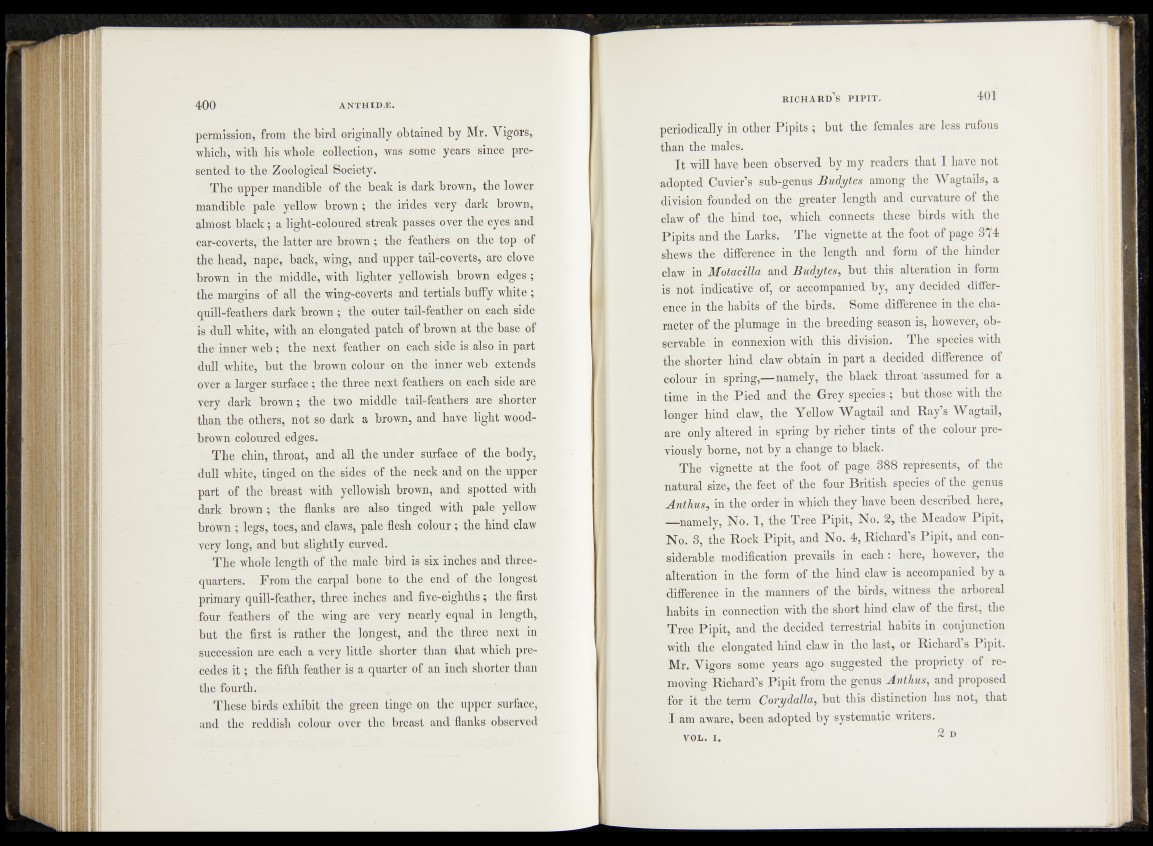
permission, from the bird originally obtained by Mr. Vigors,
which, with his whole collection, was some years since presented
to the Zoological Society.
The upper mandible of the beak is dark brown, the lower
mandible pale yellow brown ; the irides very dark brown,
almost black; a light-coloured streak passes over the eyes and
ear-coverts, the latter are brown; the feathers on the top of
the head, nape, back, wing, and upper tail-coverts, are clove
brown in the middle, with lighter yellowish brown edges ;
the margins of all the wing-coverts and tertials buffy white ;
quill-feathers dark brown ; the outer tail-feather on each side
is dull white, with an elongated patch of brown at the base of
the inner web; the next feather on each side is also in part
dull white, but the brown colour on the inner web extends
over a larger surface; the three next feathers on each side are
very dark brown; the two middle tail-feathers are shorter
than the others, not so dark a brown, and have light wood-
brown coloured edges.
The chin, throat, and all the under surface of the body,
dull white, tinged on the sides of the neck and on the upper
part of the breast with yellowish brown, and spotted with
dark brown ; the flanks are also tinged with pale yellow
brown ; legs, toes, and claws, pale flesh colour ; the hind claw
very long, and but slightly curved.
The whole length of the male bird is six inches and three-
quarters. From the carpal bone to the end of the longest
primary quill-feather, three inches and five-eighths; the first
four feathers of the wing are very nearly equal in length,
but the first is rather the longest, and the three next in
succession are each a very little shorter than that which precedes
i t ; the fifth feather is a quarter of an inch shorter than
the fourth.
These birds exhibit the green tinge on the upper surface,
and the reddish colour over the breast and flanks observed
R IC H A R D S P I P I T . 401
periodically in other Pipits ; but the females are less rufous
than the males.
I t will have been observed by my readers that I have not
adopted Cuvier’s sub-genus Budytes among the Wagtails, a
division founded on the greater length and curvature of the
claw of the hind toe, which connects these birds with the
Pipits and the Larks. The vignette at the foot of page 374
shews the difference in the length and form of the hinder
claw in Motacilla and Budytes, but this alteration in form
is not indicative of, or accompanied by, any decided difference
in the habits of the birds. Some difference in the character
of the plumage in the breeding season is, however, observable
in connexion with this division. The species with
the shorter hind claw obtain in part a decided difference of
colour in spring,—namely, the black throat 'assumed for a
time in the Pied and the Grey species ; but those with the
longer hind claw, the Yellow Wagtail and Ray’s Wagtail,
are only altered in spring by richer tints of the colour previously
borne, not by a change to black.
The vignette at the foot of page 388 represents, of the
natural size, the feet of the four British species of the genus
Anthus, in the order in which they have been described here,
—namely, No. 1, the Tree Pipit, No. % the Meadow Pipit,
No. 3, the Rock Pipit, and No. 4, Richard’s Pipit, and considerable
modification prevails in each : here, however, the
alteration in the form of the hind claw is accompanied by a
difference in the manners of the birds, witness the arboreal
habits in connection with the short hind claw of the first, the
Tree Pipit, and the decided terrestrial habits in conjunction
with the elongated hind claw in the last, or Richard s Pipit.
Mr. Vigors some years ago suggested the propriety of removing
Richard’s Pipit from the genus Anthus, and proposed
for it the term Corydalla, but this distinction has not, that
I am aware, been adopted by systematic writers.
von. i. 2 D